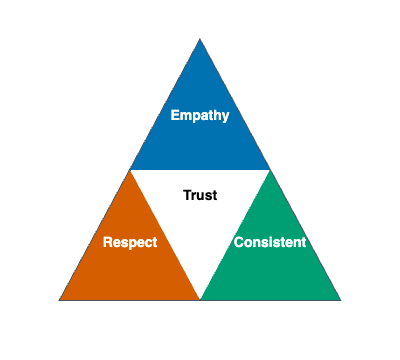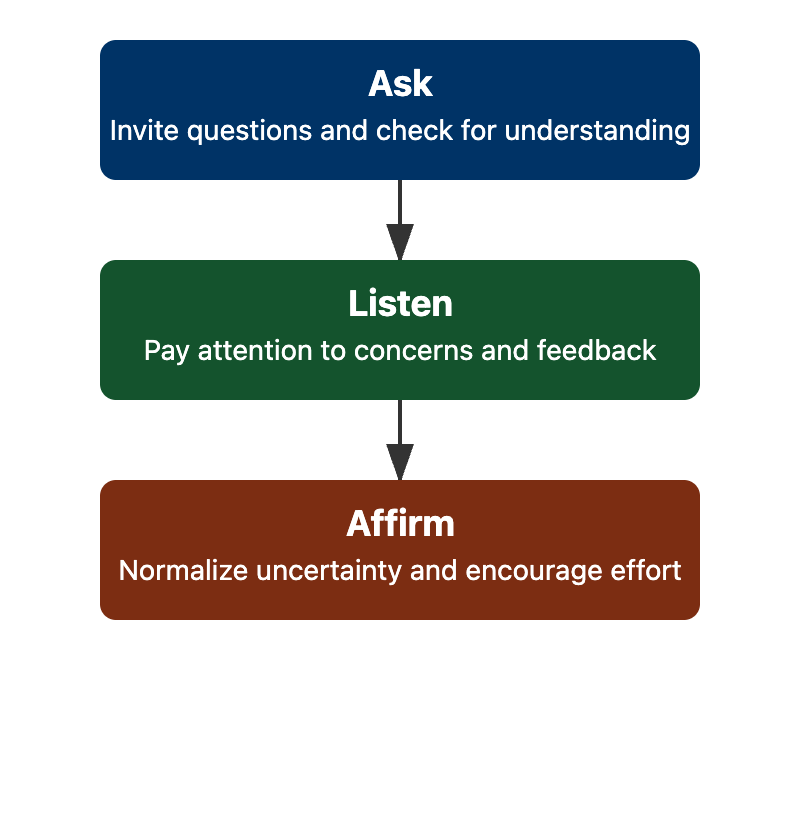As a mentor, your words and actions set the tone for your mentee’s experience. When you create a space where your mentee feels safe, respected, and encouraged, you empower them to ask questions, take risks, and grow with confidence. In this lesson, you’ll learn:
- How to foster trust and open communication
- Use inclusive language and culturally sensitive examples
- Speak with respect and avoid condescension
Trust starts with genuine care and consistent support. A helpful way to visualize this is the “Trust Triangle,” which highlights three key elements at the foundation of a strong mentoring relationship: empathy, consistency, and respect.

You can put these elements into practice by checking in proactively, rather than waiting for your mentee to reach out. For example: “How’s your first week going so far?” This shows you value their experience and well-being.
Small gestures, like remembering details they’ve shared or following up on previous conversations, also reinforce trust. For instance, “Last time you mentioned you were working on the onboarding docs. How’s that going?” This demonstrates that you’re attentive and invested in their progress.
By consistently showing empathy, being reliable, and treating your mentee with respect, you’ll create a safe space where open communication and growth can thrive.
Every person is different and comes from a unique background, so it’s important to use language and examples that are accessible to everyone. Not everyone will understand sports analogies or references to things like IKEA, but most people can relate to something universal — like how a plane takes off and lands. Choosing clear, widely understood examples helps ensure your message is inclusive.
Remember how daunting it can feel to be new. When you introduce new concepts, make sure to check for understanding and treat every question with patience and respect. An easy way to remember what to do when introducing something brand new or answering a question that the mentee seems confused on is to Ask, Listen, and Affirm.

You can use this method when checking for understanding after introducing a new topic: “Does this example make sense to you, or would a different analogy help?” This shows respect for your mentee’s learning style and invites them to speak up if something isn’t clear.
If your mentee seems confused, offer to work through it together: “Some parts can be tricky at first. Let’s work through it together and see where it clicks.” This frames learning as a shared journey and helps your mentee feel supported.
Here’s how the Ask, Listen, and Affirm looks in action:
- Natalie: Hey Milo, I’m still trying to wrap my head around how our deployment process works. I feel like I’m missing something obvious.
- Milo: That’s totally normal, Natalie. When I started, it took me a while to get comfortable with it too. Is there a particular step that feels confusing, or would it help if we walked through it together?
- Natalie: I think I get the general idea, but the part about environment variables is throwing me off.
- Milo: No problem at all. Environment variables can be tricky at first. Let’s go through them step by step, and please stop me anytime if something doesn’t make sense.
In this exchange, Milo normalizes Natalie’s uncertainty, avoids condescension, and offers specific, supportive help. He uses inclusive language and checks for understanding, making it easy for Natalie to ask questions and learn at her own pace.
By practicing empathy, inclusivity, and respect, you’ll create a foundation of trust that empowers your mentee to ask questions and grow. Up next, you’ll have the chance to apply these skills in a role-play scenario, practicing how to make your mentee feel truly welcome and supported.
